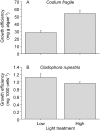Acquired phototrophy through retention of functional chloroplasts increases growth efficiency of the sea slug Elysia viridis
- PMID: 25830355
- PMCID: PMC4382131
- DOI: 10.1371/journal.pone.0120874
Acquired phototrophy through retention of functional chloroplasts increases growth efficiency of the sea slug Elysia viridis
Abstract
Photosynthesis is a fundamental process sustaining heterotrophic organisms at all trophic levels. Some mixotrophs can retain functional chloroplasts from food (kleptoplasty), and it is hypothesized that carbon acquired through kleptoplasty may enhance trophic energy transfer through increased host growth efficiency. Sacoglossan sea slugs are the only known metazoans capable of kleptoplasty, but the relative fitness contributions of heterotrophy through grazing, and phototrophy via kleptoplasts, are not well understood. Fitness benefits (i.e. increased survival or growth) of kleptoplasty in sacoglossans are commonly studied in ecologically unrealistic conditions under extended periods of complete darkness and/or starvation. We compared the growth efficiency of the sacoglossan Elysia viridis with access to algal diets providing kleptoplasts of differing functionality under ecologically relevant light conditions. Individuals fed Codium fragile, which provide highly functional kleptoplasts, nearly doubled their growth efficiency under high compared to low light. In contrast, individuals fed Cladophora rupestris, which provided kleptoplasts of limited functionality, showed no difference in growth efficiency between light treatments. Slugs feeding on Codium, but not on Cladophora, showed higher relative electron transport rates (rETR) in high compared to low light. Furthermore, there were no differences in the consumption rates of the slugs between different light treatments, and only small differences in nutritional traits of algal diets, indicating that the increased growth efficiency of E. viridis feeding on Codium was due to retention of functional kleptoplasts. Our results show that functional kleptoplasts from Codium can provide sacoglossan sea slugs with fitness advantages through photosynthesis.
Conflict of interest statement
Figures



Similar articles
-
Kleptoplast photosynthesis is nutritionally relevant in the sea slug Elysia viridis.Sci Rep. 2017 Aug 10;7(1):7714. doi: 10.1038/s41598-017-08002-0. Sci Rep. 2017. PMID: 28798379 Free PMC article.
-
Food shaped photosynthesis: Photophysiology of the sea slug Elysia viridis fed with two alternative chloroplast donors.Open Res Eur. 2024 Mar 13;3:107. doi: 10.12688/openreseurope.16162.2. eCollection 2023. Open Res Eur. 2024. PMID: 38725452 Free PMC article.
-
Photosynthetic sea slugs induce protective changes to the light reactions of the chloroplasts they steal from algae.Elife. 2020 Oct 20;9:e57389. doi: 10.7554/eLife.57389. Elife. 2020. PMID: 33077025 Free PMC article.
-
Crawling leaves: photosynthesis in sacoglossan sea slugs.J Exp Bot. 2013 Oct;64(13):3999-4009. doi: 10.1093/jxb/ert197. Epub 2013 Jul 11. J Exp Bot. 2013. PMID: 23846876 Review.
-
Photophysiology of kleptoplasts: photosynthetic use of light by chloroplasts living in animal cells.Philos Trans R Soc Lond B Biol Sci. 2014 Mar 3;369(1640):20130242. doi: 10.1098/rstb.2013.0242. Print 2014 Apr 19. Philos Trans R Soc Lond B Biol Sci. 2014. PMID: 24591722 Free PMC article. Review.
Cited by
-
How does temperature affect functional kleptoplasty? Comparing populations of the solar-powered sister-species Elysia timida Risso, 1818 and Elysia cornigera Nuttall, 1989 (Gastropoda: Sacoglossa).Front Zool. 2018 Apr 24;15:17. doi: 10.1186/s12983-018-0264-y. eCollection 2018. Front Zool. 2018. PMID: 29760759 Free PMC article.
-
Kleptoplasty: Getting away with stolen chloroplasts.PLoS Biol. 2022 Nov 8;20(11):e3001857. doi: 10.1371/journal.pbio.3001857. eCollection 2022 Nov. PLoS Biol. 2022. PMID: 36346789 Free PMC article.
-
On Being the Right Size as an Animal with Plastids.Front Plant Sci. 2017 Aug 17;8:1402. doi: 10.3389/fpls.2017.01402. eCollection 2017. Front Plant Sci. 2017. PMID: 28861094 Free PMC article. Review.
-
Kleptoplast photosynthesis is nutritionally relevant in the sea slug Elysia viridis.Sci Rep. 2017 Aug 10;7(1):7714. doi: 10.1038/s41598-017-08002-0. Sci Rep. 2017. PMID: 28798379 Free PMC article.
-
Photosynthesis from stolen chloroplasts can support sea slug reproductive fitness.Proc Biol Sci. 2021 Sep 29;288(1959):20211779. doi: 10.1098/rspb.2021.1779. Epub 2021 Sep 29. Proc Biol Sci. 2021. PMID: 34583582 Free PMC article.
References
-
- Jones RI. Mixotrophy in planktonic protists as a spectrum of nutritional strategies. Mar Microb Food Webs. 1994;8: 87–96.
-
- Stoecker DK, Johnson MD, de Vargas C, Not F. Acquired phototrophy in aquatic protists. Aquat Microb Ecol. 2009;57: 279–310.
Publication types
MeSH terms
LinkOut - more resources
Full Text Sources
Other Literature Sources
Research Materials

